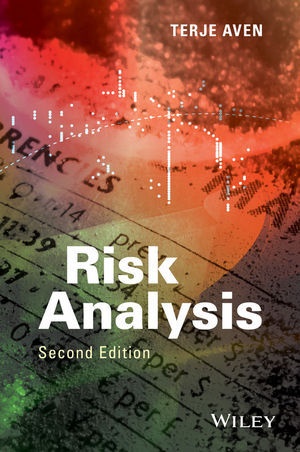Read more
Risk Analysis, Second Edition
Terje Aven, University of Stavanger, Norway
A practical guide to the varied challenges presented in the ever-growing field of risk analysis.
Risk Analysis presents an accessible and concise guide to performing risk analysis, in a wide variety of field, with minimal prior knowledge required. Forming an ideal companion volume to Aven's previous Wiley text Foundations of Risk Analysis, it provides clear recommendations and guidance in the planning, execution anduse of risk analysis.
This new edition presents recent developments related to risk conceptualization, focusing on related issues on risk assessment and their application. New examples are also featured to clarify the reader's understanding in the application of risk analysis and the risk analysis process.
Key features:
* Fully updated to include recent developments related to risk conceptualization
and related issues on risk assessments and their applications.
* Emphasizes the decision making context of risk analysis rather than
just computing probabilities
* Demonstrates how to carry out predictive risk analysis using a variety of case studies and examples.
* Written by an experienced expert in the field, in a style suitable for both
industrial and academic audiences.
This book is ideal for advanced undergraduates, graduates, analysts and researchers from statistics, engineering, finance, medicine and physical sciences. Managers facing decision making problems involving risk and uncertainty will also benefit from this book.
List of contents
Preface ix
1 What is a risk analysis? 1
1.1 Why risk analysis? 3
1.2 Risk management 4
1.2.1 Decision-making under uncertainty 6
1.3 Examples: decision situations 11
1.3.1 Risk analysis for a tunnel 11
1.3.2 Risk analysis for an offshore installation 11
1.3.3 Risk analysis related to a cash depot 12
2 What is risk? 13
2.1 The risk concept and its description 13
2.2 Vulnerability 19
2.3 How to describe risk quantitatively 19
2.3.1 Description of risk in a financial context 21
2.3.2 Description of risk in a safety context 22
2.4 Qualitative judgements 24
3 The risk analysis process: planning 28
3.1 Problem definition 28
3.2 Selection of analysis method 33
3.2.1 Checklist-based approach 35
3.2.2 Risk-based approach 36
4 The risk analysis process: risk assessment 38
4.1 Identification of initiating events 38
4.2 Cause analysis 39
4.3 Consequence analysis 40
4.4 Probabilities and uncertainties 42
4.5 Risk picture: risk presentation 43
4.5.1 Handling the background knowledge 46
4.5.2 Risk evaluation 47
5 The risk analysis process: risk treatment 49
5.1 Comparisons of alternatives 49
5.1.1 How to assess measures? 51
5.2 Management review and judgement 53
6 Risk analysis methods 55
6.1 Coarse risk analysis 55
6.2 Job safety analysis 60
6.3 Failure modes and effects analysis 62
6.3.1 Strengths and weaknesses of an FMEA 68
6.4 Hazard and operability studies 69
6.5 SWIFT 70
6.6 Fault tree analysis 70
6.6.1 Qualitative analysis 73
6.6.2 Quantitative analysis 75
6.7 Event tree analysis 77
6.7.1 Barrier block diagrams 79
6.8 Bayesian networks 79
6.9 Monte Carlo simulation 82
7 Safety measures for a road tunnel 84
7.1 Planning 84
7.1.1 Problem definition 84
7.1.2 Selection of analysis method 85
7.2 Risk assessment 86
7.2.1 Identification of initiating events 86
7.2.2 Cause analysis 88
7.2.3 Consequence analysis 88
7.2.4 Risk picture 91
7.3 Risk treatment 93
7.3.1 Comparison of alternatives 93
7.3.2 Management review and decision 93
8 Risk analysis process for an offshore installation 95
8.1 Planning 95
8.1.1 Problem definition 95
8.1.2 Selection of analysis method 96
8.2 Risk analysis 96
8.2.1 Hazard identification 96
8.2.2 Cause analysis 96
8.2.3 Consequence analysis 99
8.3 Risk picture and comparison of alternatives 101
8.4 Management review and judgement 102
9 Production assurance 103
9.1 Planning 103
9.2 Risk analysis 103
9.2.1 Identification of failures 103
9.2.2 Cause analysis 104
9.2.3 Consequence analysis 104
9.3 Risk picture and comparison of alternatives 106
9.4 Management review and judgement. Decision 107
10 Risk analysis process for a cash depot 108
10.1 Planning 108
10.1.1 Problem definition 108
10.1.2 Selection of analysis method 109
10.2 Risk analysis 110
10.2.1 Identification of hazards and threats 110
10.2.2 Cause analysis 110
10.2.3 Consequence analysis 113
10.3 Risk picture 115
10.4 Risk-reducing measures 117
10.
About the author
Terje Aven, University of Stavanger, Norway.
Summary
Risk Analysis, Second Edition Terje Aven, University of Stavanger, Norway A practical guide to the varied challenges presented in the ever-growing field of risk analysis.

